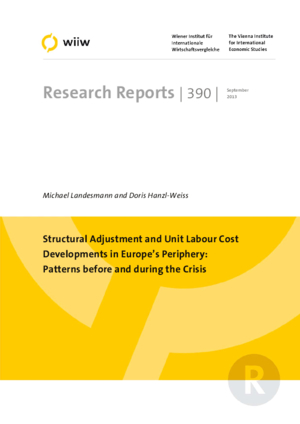Structural Adjustment and Unit Labour Cost Developments in Europe’s Periphery: Patterns before and during the Crisis
Doris Hanzl-Weiss and Michael Landesmann
wiiw Research Report No. 390, September 2013
39 pages including 2 Tables and 12 Figures
Abstract
This paper analyses developments in production structures in pre-crisis and during the crisis years in the range of EU ‘peripheral economies’ (i.e. the lower- and medium-income economies in the South and the Centre/East). The emphasis is on the development of the tradable sector (and manufacturing in particular) relative to non-tradable sectors and whether these are reflected in longer-term trade imbalances. Different groups of economies emerge, some with a strong manufacturing base, others with a very weak one. We investigate whether and to which extent structural readjustments took place during the crisis years and also analyse in detail relative unit labour cost (ULC) developments across sectors. A decomposition analysis shows that ULC developments are mainly driven during the crisis by output and employment adjustments (rather than by labour compensation) posing the question of whether capacity contraction effects might make ‘weak economies’ in the EU’s periphery even more ‘trade balance constrained’ in the wake of the crisis.
Reference to wiiw databases: wiiw Annual Database
Keywords: tradable sector, non-tradable sector, real effective exchange rates, unit labour costs, Europe’s peripheral economies, trade and current account imbalances, structural developments in Europe’s periphery, Central and Southeast Europe
JEL classification: O10, O14, J3
Countries covered: European Union, SEE
Research Areas: Macroeconomic Analysis and Policy
